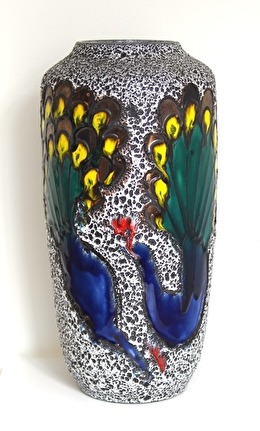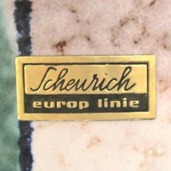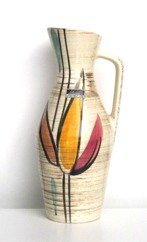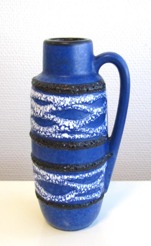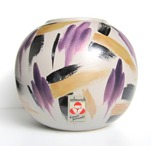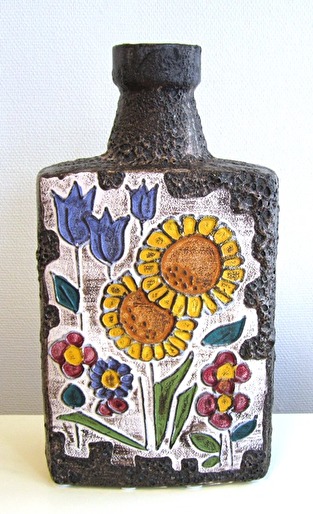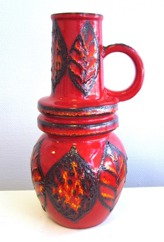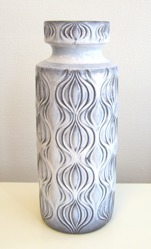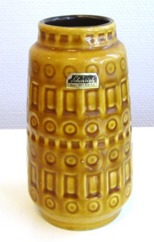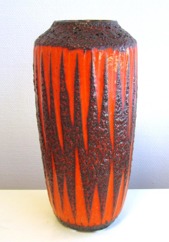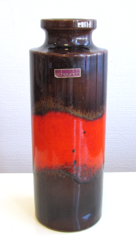Scheurich & Greulich 1948-1953 (1968)
Scheurich 1954-Present
Scheurich 1954-Present
History
Alois Scheurich and his cousin Fridolin Greulich started in 1928 a wholesale company in glass, porcelain and ceramics in Schneeberg. 1938 moved the business to Kleinheubach. In 1948 they started their own production of household ceramics sold under the name "Scheurich & Greulich."
1954 continued Alois Scheurich the ceramic production on his own and founded Scheurich Keramikfabrik KG. The old company Scheurich and Greulich continued the wholesale business until 1968 (Dieterle 2008) and probably also sold Scheurich ceramics under their own name.
In 1955 the designer Heinz Siery joined Scheurich. He had previously worked for Fohr. Heinz Siery worked not only with design. He also developed and introduced new production methods. The strategy was to develop relatively simple shapes that could be decorated with many different glazes and thus get a large range that easily could be changed according to customer preference. The pottery was also cheap to produce and Scheurich was able to keep prices low and thus quickly gain market share. The strategy was very successful and Scheurich was the company that produced most ceramics of all companies during the 60s, 70s and 80s. Much of the production was also exported. In the 90s production of art ceramics ceased but Scheurich continued to produce flower pots. Today Scheurich is the market leader for indoor-pots and accessories for flowers and plants in Europe.
Shapes and decors
The chosen production strategy meant quite simple, strict forms typical of Scheurich. Many different forms in combination with all the different decors and glazes gave a very extensive range of pieces. Heinz Siery often used "the golden ratio" in its design, which gave the ceramics beautiful, harmonious proportions. This is clearly seen in the vase 271 22 presented in 1959. It became one of the most successful forms and continued to be manufactured in the 70s and was made in over 250 different decors.
Ceramics from the 50s and early 60s are typical of their time with relative discrete colors and geometric patterns. 60s and especially 70s ceramics were characterized by brown and green color schemes with touches of vibrant colors but there are also many colorful decors with bold lava glazes that is now highly sought after by collectors. During the late 80s, both the shapes and the color scales became more plain and the ceramic is less interesting for collectors today.
Scheurich 517 45. A decor with two peacocks and
a white and black lava glaze. 1970s.
Designers
Heinz Siery 1955-1959.
Oswald Kleudgen (glazes and decors) 1955-
Franz Karl 1963-1969.
A. Seide 1970-1973.
Monica Schödel-Müller.
Werner Nowka.
Scheurich 271 22 by Heinz Siery, presented 1959. This example is made 1960-1962.
Moulded decors inspired by different patterns from nature is also typical of Scheurich. Some examples are "Amsterdam" resembling tulip bulbs and "Jura" that look like fossils. Other molded decorations are inspired by ancient cultures, such as the decoration "Inca".
A more abstract decoration with a colorful glaze is "Lora", characterized by a zig-zag pattern in combination with a bubbly lava glaze. The decoration "Fabiola" is an example of a simple smooth glaze with a wide red stripe overlying a dark brown background. The decoration was popular and was made in many different forms.
A series with a relatively complex shape is the serie "Vienna" by A Seide. The shape look like an inverted light bulb. The biggest vase Scheurich made was a 65 cm high "Vienna" (428-65).
Scheurich 281 54. An example of a very big floor wase.
